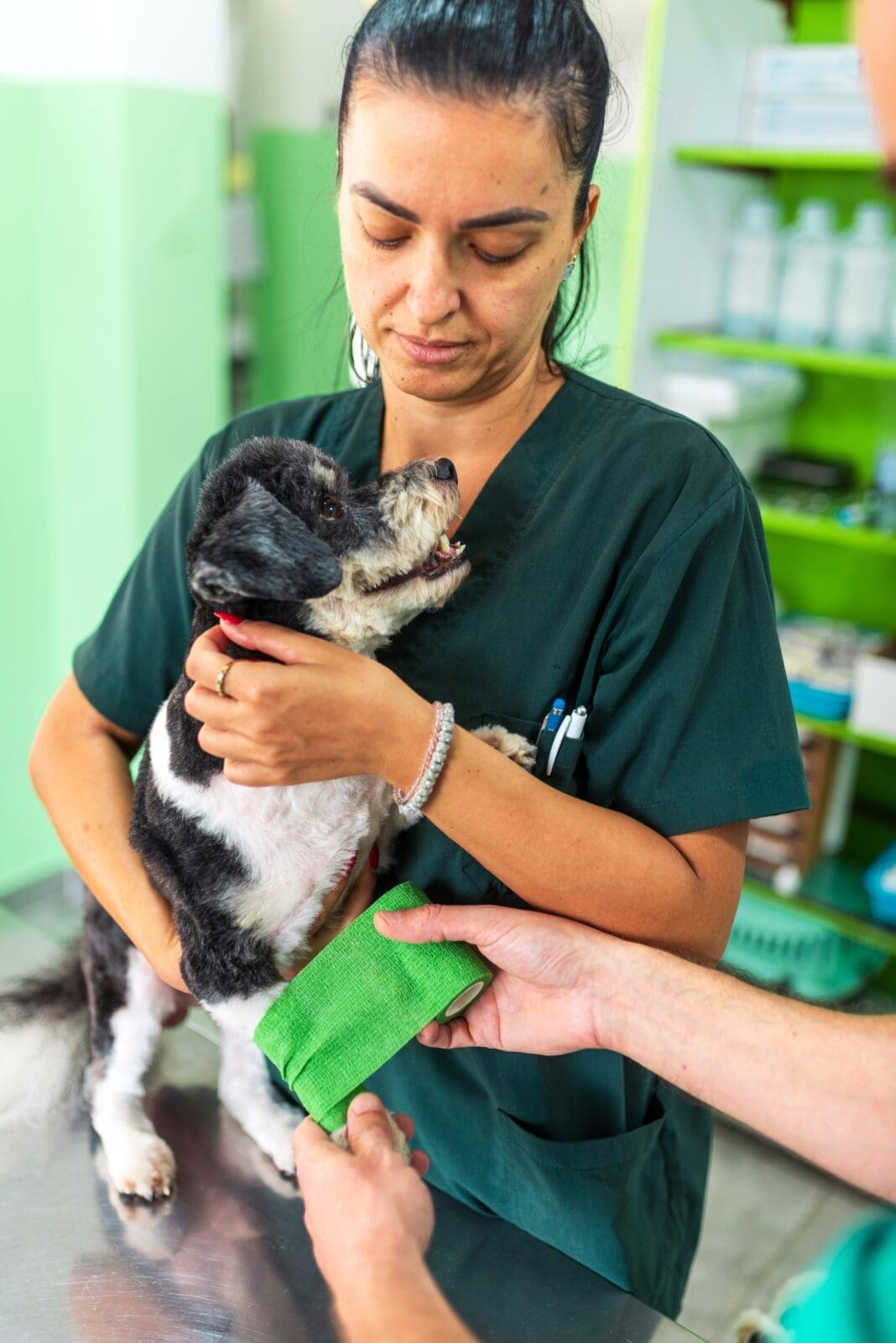Veterinary Support Assistant CV Guide
Everything you need to know about getting the perfect Veterinary Support Assistant CV
A veterinary support assistant helps with animal care in veterinary practices. The role involves many responsibilities and a dedication to animal care, which you must demonstrate to prospective employers when applying for jobs in this field. One crucial way to do this is to craft an exceptional and standout CV.
Whether you want to become a veterinary support assistant or move into a new role, your CV should showcase your relevant skills, experience, qualifications and passion for animals. A professional CV that is well thought out and tailored to the position will maximise your chances of a successful application.
In this article, we will provide guidance on how to write a veterinary support assistant CV, what to include, some tips and an example to help you get started. It will hopefully increase your chances of securing an interview and, ultimately, the job.
In this Veterinary Support Assistant CV guide
What to include in a Veterinary Support Assistant CV
You may have come across many templates and examples of CVs online, but when you are sitting down to write your own, you may wonder what to include to catch the eyes of recruiters. One of the most important things to remember before writing your CV is to tailor it to each veterinary support assistant position you apply for. Just sending generic CVs will give recruiters the impression that you have not done your research and are not bothered about the role, which may affect your chances of getting an interview.
Your CV should clearly and concisely showcase your education, key skills and attributes and not contain unnecessary or too much information. It should also be relevant to you and accurately and honestly reflect your achievements and experiences. Properly planning and organising your information will help you write an engaging and professional-looking CV and stand out from the competition.
Knowing where to start can sometimes be difficult, but breaking your CV into manageable sections can make the task feel less daunting. Let us now look at how you can do this step-by-step.
Contact information
The first and probably easiest section of your CV is your contact information. It typically goes at the top of the page, but you may see some examples with these details on the side. Regardless of the format, it is vital to ensure the information is clear and up-to-date to make it easier for potential employers to contact you.
This section should include your name, location, email address and phone number. Use a professional-looking email address and one that you check regularly; avoid nicknames, aliases and social media handles. Also, provide a current phone number where recruiters can easily reach you.
You can also add a LinkedIn profile, website or an online portfolio, but it is not mandatory. Only include it if it is relevant to the position.
There is some information you do not need to provide or should avoid, such as:
- A full address – just add your town, city or county.
- Your date of birth.
- Other personal information, such as marital status, gender, nationality or religion.
- A photo, unless the job posting asks for one.
This information is irrelevant to your professional qualifications, can lead to bias and may detract from important parts.
Here is an example: Jane Smith. Crawley, West Sussex. Email: janesmith@example.com. Phone: +44 1234 567890.
Professional summary (career objective statement)
The next section of your CV, under your contact information, is your professional summary, which is also known as your career objective statement, personal statement, or professional profile. It is a brief overview of your relevant qualifications, skills, career goals and experience, and it is typically the first thing an employer will read through. Therefore, it should be clear, concise, impactful, and no longer than five lines.
Here is some guidance to help you create an engaging and effective summary:
- Begin with a succinct, powerful statement highlighting your key attributes and experience.
- Specify your current job title, years of experience in veterinary support and any notable achievements or responsibilities in previous roles.
- Highlight your key skills, e.g. animal care and handling, medical assistance, client communication, team collaboration and administrative tasks.
- Emphasise your strengths, such as working in fast-paced environments, attention to detail and teamwork.
- Demonstrate your passion for animal welfare and dedication to providing high-quality care.
- Tailor the summary to match the specific job you are applying for, reflecting the language and priorities of the job description.
A well-crafted and engaging professional summary will capture recruiters’ interest and encourage them to read through the rest of your CV.
Here is an example of a professional summary:
“Experienced and dedicated veterinary support assistant with over 3 years of hands-on experience in animal care and medical support. Skilled in animal handling, medical assistance, client communication and administrative tasks. Adept at assisting veterinarians during procedures, maintaining medical records and ensuring a clean and safe environment for animals. Passionate about animal welfare and committed to providing the best care.”
Education
Your CV should have an education section that details relevant qualifications, certifications and training relevant to the veterinary support assistant role. It can come after your professional summary if you have limited work experience in the field. Some add their work experience first if they have fewer qualifications. It is up to you which you add first.
This section helps recruiters identify whether you have the necessary academic background and qualifications for the veterinary support assistant role and quickly assess your suitability for the position. It also shows your commitment to learning and professional development.
When you complete your education section, add your qualifications in reverse chronological order, i.e. most recent first. Here are some examples of what to include:
- Formal education – includes any relevant degrees, diplomas, A levels, apprenticeships and GCSEs relevant to veterinary care, animal science or a related field. You should add the following:
- Qualification or degree name.
- Institution name and location.
- Attendance or graduation dates (or present if you are still studying).
- Any relevant coursework or modules (optional).
- Additional training – highlight specific courses or training directly related to veterinary support, animal care or medical assistance. Give the course name, location of training and date of completion.
This section will typically be longer if you have limited work experience, especially if you have recently left school or are a recent graduate. If you already have experience as a veterinary support assistant, you may want to focus on your work experience and have a shorter education section.
Work experience
The next section after your education is your work experience, which is also entitled employment history in some CVs, and you can add details of relevant paid or voluntary work experience. It summarises your professional background, showcasing your skills, achievements, competence and career progression.
Recruiters use the work experience section to assess your suitability for the role, evaluating your previous job responsibilities and how they align with the position’s requirements. Therefore, use this section to emphasise why you are the ideal candidate for the job.
Your work experience should be relevant and in reverse chronological order (most recent first). Here are some examples of what to include for each position:
- Job title: Begin with your job title, e.g. “Veterinary Support Assistant”.
- Employer/organisation name: Name of the veterinary practice or organisation.
- Location: Town, city or county.
- Dates of employment: Clearly indicate employment start and end dates (month/year or present if still working there).
- Responsibilities: Highlight key duties and tasks you performed (aim for three to five bullet points and use action verbs to describe your tasks). You can also include achievements and skills gained. Here are some examples:
- Assisted veterinarians during examinations, treatments and surgeries.
- Administered medications and vaccinations under the supervision of veterinarians.
- Provided care and comfort to animals before and after procedures.
- Monitored the health and behaviour of animals, reporting any concerns to the veterinary team.
- Scheduled appointments and managed patient records using practice management software.
You can use this section to showcase any volunteering, projects, coursework and internships if you have limited work experience. We will cover how to describe your experience later.
Key skills and achievements
Your key skills and achievements come after your work experience, and they showcase your accomplishments and core competencies and what you have achieved in your previous roles. It makes it easier for prospective employers to see why you are a strong candidate and how you can add value to their organisation. It also helps you stand out from other applicants with similar work experience.
When you add your key skills to your CV, you want to ensure they are relevant to the veterinary support assistant job, so read through the job description to see what the employer is looking for and add a mixture of hard and soft skills to demonstrate your
abilities, for example:
- Hard skills – are specific, teachable abilities or knowledge that are typically easy to quantify and often acquired through education, training programs or on-the-job experience. Examples of hard skills for a veterinary support assistant might include animal handling, medical knowledge, veterinary terminology, anaesthesia monitoring, laboratory skills, administrative tasks, etc.
- Soft skills – are more subjective, involving interpersonal skills and personal attributes that are often harder to quantify but are equally important. Soft skills for a veterinary support assistant might include compassion, empathy, communication, teamwork, attention to detail, customer service, etc.
Here is an example of how to add your skills:
- Proficient in animal handling and restraint techniques.
- Competent in veterinary practice management software.
- Strong knowledge of veterinary terminology and procedures.
- Excellent communication and customer service skills for interacting with pet owners.
Concentrate on transferable soft skills as above and any hard skills acquired from your education if you have limited experience in the field.
When it comes to including your achievements, you can either create a separate section titled “Achievements” or integrate them within your “Work Experience” section under each relevant role. We will look at how you can focus on your achievements later.
A handy tip is to identify any keywords in the job description and include these in your CV here relevant. Some organisations use Applicant Tracking Systems (ATS), which scan for keywords in candidates CVs. Your CV will have more chance of passing through the ATS filter if you align it with the employer’s requirements.
Other information
Your CV for the veterinary support assistant position should at least cover your qualifications, work experience and skills, which are the sections we have covered so far. If you have other relevant information that you think can increase your chances of getting an interview, you can add additional sections to your CV, such as:
- Professional development – list any workshops, courses, training or seminars you have attended that are relevant to the veterinary support assistant role.
- Volunteer experience – if you have volunteered, include this experience to showcase your dedication and skills, e.g. volunteering with animals, wildlife, customers, etc. You can include this in the work experience section if you have not had many relevant paid jobs. If you do include it, detail the name of the organisation, the dates you volunteered and your key duties and contributions.
- Hobbies and interests – this information helps to show your personality and how well-rounded you are. Focus on those that highlight skills or qualities beneficial to the role, e.g. animal care.
- Languages – specify any additional languages you speak, along with your proficiency levels.
- Professional affiliations – mention any relevant professional organisations or groups you are a member of.
- Publications, research and projects – list articles, papers, research or projects you have worked on related to veterinary support, and detail your role and the outcomes. You could also mention any presentations delivered on the topic.
These additional sections can give potential employers a more comprehensive view of your qualifications, personality, and passion for animals.
References
The references section is typically the last in your CV and is straightforward. It enables prospective employers to check your information and confirm you are credible. Having strong references can set you apart from other applicants.
It is not always necessary to include references directly on your CV; you can state that references are available upon request if the job posting does not ask for specific details and you are struggling for space.
If the job advert asks for details of your references, and most will ask for two, choose individuals who can attest to your qualifications, skills, experience and character. You should ask them if they are happy to provide a reference before including them in your CV and ensure their contact information is up-to-date and accurate.
When you include information about your references, ensure it is clear and concise and makes it easy for prospective employers to contact them. Here is an example of what to include:
- Reference name.
- The current job title or position of your reference.
- The name of the company or organisation where your reference works.
- A professional email address for the reference.
- A direct phone number where recruiters can easily reach them.
- A brief description of your relationship with the reference, e.g. “Former Manager,” “Colleague,” or “Mentor”.
Tips for writing a Veterinary Support Assistant CV
So far, we have covered some sections you can include in your CV, but how do you actually go about writing it? First, there are some general rules surrounding CVs, and it is important to understand these to avoid making simple mistakes. Here are some tips:
- Tailor, tailor, tailor! – it cannot be emphasised enough to make your CV specific and tailor it to each veterinary support assistant position you apply for. Read the job description thoroughly and research the organisation to create a CV that reflects your dedication and passion.
- Keep it short and sweet – recruiters will unlikely have the time to read through overly complex and detailed CVs. Therefore, it is vital to keep your CV no longer than two pages and ensure it is clear and concise. Ensure your qualifications, experience, contributions, and skills stand out and avoid adding irrelevant information and vague statements.
- Avoid exaggerating – while you want to maximise the chances of getting an interview invite, keep your CV accurate and be honest about your qualifications, experience, achievements and skills. Interviewers can easily spot candidates who have over-exaggerated or been untruthful in their CVs, which can have serious repercussions.
- Use action verbs – start each bullet point with strong action verbs like “managed,” “developed,” “implemented,” or “achieved” to make your accomplishments stand out. Avoid phrases such as “hardworking” or “team player”, as these are overused and lack specificity.
- Use professional and consistent formatting – you can help your CV stand out by:
- Using a clean, professional layout with clear sections, headings and bullet points.
- Using professional, simple and clear language, avoiding slang or overly casual expressions.
- Using the same tense throughout your CV. Typically, past tense for previous jobs and present tense for your current role.
- Avoiding excessive use of colours and fonts.
- Sticking to a simple font like Arial, Calibri or Times New Roman and consistent size, e.g. 10-12 points.
- Ensuring your CV has adequate spacing to make it more visually appealing.
- Avoiding using photos, as it can distract and lead to bias.
- Using a digital format where possible. Save and send your CV as a PDF to ensure the formatting stays intact when viewed on different devices.
- Make sure you proofread and review your CV – double-check for spelling and grammatical errors and proofread it before sending, as a CV full of mistakes will not create a good impression. Ask a family member, friend or mentor to review your CV and give you feedback.
While rushing through a CV may be tempting, it will likely result in an unsuccessful application. Take the time to really think about your CV and ensure it is well-written to increase your chances of getting that interview.

Focus on achievements
When you add achievements to your CV, focus on specific accomplishments demonstrating your skills, abilities and contributions in previous roles. It shows potential employers your expertise, dedication and the value you could bring to a veterinary practice, which can set you apart from other candidates who may have similar qualifications and experience.
Like the rest of your CV, you should tailor your achievements to align with the key skills and requirements listed in the job description. Here are some tips on other things to focus on when detailing your accomplishments:
- Place the most impressive and relevant achievements at the top of each section to ensure recruiters see them first and make a strong initial impression.
- Reflect on your past roles and identify achievements most relevant to the veterinary support assistant position you are applying for. Think about times when you made a significant impact, solved problems, improved processes or received recognition. Give specific examples detailing what you did, how you did it and the outcome.
- Start each bullet point with a strong action verb to clearly describe your accomplishments. For example, use words like “implemented,” “improved,” “led,” “managed,” “increased,” “reduced,” “developed,” etc.
- Provide sufficient context to clarify your achievements and help employers understand the significance of your accomplishments. Mention specific challenges you faced, the actions you took, and the results.
- Where possible, quantify your achievements, i.e. use numbers, percentages or other metrics to clearly demonstrate the impact and provide concrete evidence of your contributions. Here are some examples of how to do this:
- “Received positive feedback from 95% of clients for exceptional care and service”.
- “Successfully assisted in the recovery of over 100 post-operative animals, ensuring their comfort and safety”.
- Implemented a new organisational system for medical supplies, reducing retrieval time by 20%.
- Structure your achievements using the STAR method (Situation, Task, Action, Result) to showcase your accomplishments, for example:
- Situation: What was the context or problem?
- Task: What was your task or responsibility?
- Action: What specific actions did you take to address it?
- Result: What were the outcomes or benefits?
By focusing on your achievements in this way in your CV, you can effectively demonstrate your value and make a strong case for why you are the ideal candidate for the role. It strengthens your application and gives potential employers confidence in your abilities and contributions.
Describe your experience
To capture recruiters’ eyes, you should describe your experience in a way that showcases your qualifications, skills and the value you can bring to the role and organisation. It builds credibility, helps employers assess your fit for the role and sets you apart from other candidates. Here are some ways you can describe your experience in your CV:
- Review the job description and tailor each section of your CV to your specific experiences and the job you are applying for. Only include experiences relevant to the veterinary support assistant role.
- Briefly mention your key experiences in your professional summary to grab the employer’s attention.
- In the work experience section, focus on your achievements and responsibilities in each role.
- Include any relevant voluntary experience and highlight the difference you made in these roles.
Even if you do not have direct experience as a veterinary support assistant, you can create a compelling CV by highlighting your transferable skills, relevant qualifications and passion for animal care. Here is some guidance on what to do in this situation:
- Education – include any qualifications related to animal care or science, even if they are not directly veterinary-related, e.g. biology or zoology.
- Volunteering and internships – If you have volunteered or interned in roles related to animal care, include them in your experience. Mention your role, the organisation, dates and an overview of your responsibilities.
- Transferable skills from other jobs – highlight experiences from other roles where you gained transferable skills useful for veterinary support, such as customer service, teamwork, animal handling, time management, organisation, time management, attention to detail, etc.
- Personal attributes – demonstrate personal qualities important in the veterinary field, such as compassion, empathy, patience, reliability and a willingness to learn.
- Professional development and certifications – mention any workshops, seminars, courses or additional training related to veterinary support and assistance, animal handling, first aid for animals or animal welfare.
- Extracurricular activities – include any extracurricular activities that showcase your skills and interests, e.g. involvement in animal care, animal clubs, pet sitting, dog walking, etc.
- Demonstrate passion – write a professional summary emphasising your relevant education, transferable skills and commitment to the field. For example, “Passionate and dedicated individual with a strong interest in animal care and welfare. Experienced in handling animals through volunteering and pet-sitting activities. Excellent communication and organisational skills. Detail-oriented and compassionate, ensuring the highest standard of care. Eager to support veterinary teams and contribute to exceptional animal care”.

Tailor your CV to the Veterinary Support Assistant position
Each organisation and veterinary support assistant role will be unique, and individual employers will stipulate specific requirements in their job postings. Therefore, it is essential to tailor your CV to demonstrate to recruiters that you have done your homework and are genuinely interested in the position. A customised CV also helps match your strengths to the job requirements, increasing your chances of getting noticed.
When tailoring your CV, you want to highlight your relevant qualifications, skills and experiences to stand out from other candidates. Here are some tips to help you customise your CV:
- Read through the job description carefully – it seems obvious, but studying the details in the job posting will help you understand what the organisation is looking for in a veterinary support assistant so you can include the most relevant information in your CV. Highlight the most relevant experiences and skills that align with the job description to show how you fit the role.
- Research the organisation – if you know the organisation name at this stage, as some recruiters do not divulge this information until later in the process, do some research. Look at their website, social media feed and any recent news to use in your CV. You can mention how you fit their goals, ethos, values, specific needs, and the contribution you could make.
- Customise sections of your CV – there are several ways to do this, e.g.:
- Craft a professional summary that reflects your passion for animal care and addresses how your background, skills and values align with the organisation’s needs. Mention specific aspects of the organisation and its goals that resonate with you.
- Customise the bullet points in your work experience section and align your experiences with the job requirements. Use the same language as the job description when possible, e.g. if it details scheduling appointments and managing patient records, include examples of this experience.
- Use specific achievements relevant to the role, e.g. if the job posting details working with specific domestic animals highlight related achievements. For example, “Implemented a new enrichment program for rescue dogs, resulting in a 30% increase in their overall well-being and reduced stress levels, as measured by veterinary assessments”.
- Match your skills section to the keywords in the job description and focus on those most relevant to the position, e.g. if it highlights customer service skills, emphasise your experience in that area.
- If the job description mentions specific certifications, training or professional memberships, include these in your CV.
- Use keywords – as stated, some organisations use applicant tracking systems (ATS) that filter applications based on keywords. As you read through the job description, highlight any keywords the organisation uses and incorporate them in your CV where relevant. It increases your chances of passing through these filters and getting an interview.
- Do not forget to tailor your cover letter – customise your cover letter for each application, highlighting specific experiences, achievements and skills that align with the role. Use examples from your CV to support your claims and detail what makes you a perfect fit for the veterinary support assistant position.
By tailoring your CV, you can show potential employers that you have taken the time to understand their needs and are well-suited for the position.
Good luck!



